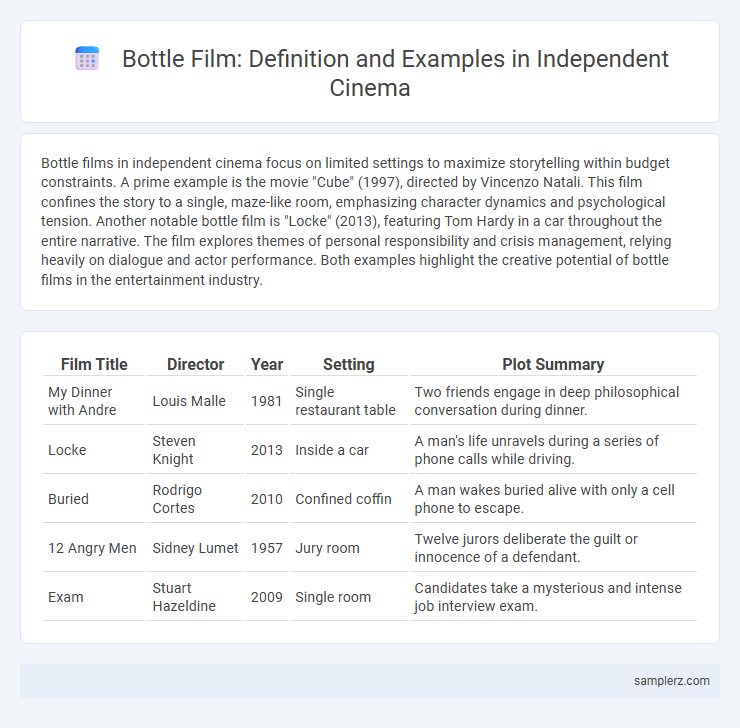Bottle films in independent cinema focus on limited settings to maximize storytelling within budget constraints. A prime example is the movie "Cube" (1997), directed by Vincenzo Natali. This film confines the story to a single, maze-like room, emphasizing character dynamics and psychological tension. Another notable bottle film is "Locke" (2013), featuring Tom Hardy in a car throughout the entire narrative. The film explores themes of personal responsibility and crisis management, relying heavily on dialogue and actor performance. Both examples highlight the creative potential of bottle films in the entertainment industry.
Table of Comparison
| Film Title | Director | Year | Setting | Plot Summary |
|---|---|---|---|---|
| My Dinner with Andre | Louis Malle | 1981 | Single restaurant table | Two friends engage in deep philosophical conversation during dinner. |
| Locke | Steven Knight | 2013 | Inside a car | A man's life unravels during a series of phone calls while driving. |
| Buried | Rodrigo Cortes | 2010 | Confined coffin | A man wakes buried alive with only a cell phone to escape. |
| 12 Angry Men | Sidney Lumet | 1957 | Jury room | Twelve jurors deliberate the guilt or innocence of a defendant. |
| Exam | Stuart Hazeldine | 2009 | Single room | Candidates take a mysterious and intense job interview exam. |
Defining Bottle Films in Independent Cinema
Bottle films in independent cinema are characterized by their minimalistic settings, typically confined to a single location, maximizing narrative tension and character development. These films use limited space to explore complex themes and intimate dynamics without relying on extensive production resources, exemplified by movies like "Locke" and "Tape." The genre's constraint-driven approach emphasizes dialogue and psychological depth, making it a distinctive and resource-efficient storytelling method in indie filmmaking.
Key Traits of Indie Bottle Films
Indie bottle films often showcase minimalistic settings, confined largely to a single location such as an apartment or car, emphasizing character development and dialogue over elaborate effects. These films rely on limited budgets, fostering creative storytelling through intense emotional exchanges and suspenseful scenarios. Key traits include strong character-driven narratives, claustrophobic atmospheres, and innovative use of sound and lighting to heighten tension.
Classic Indie Bottle Film: “Clerks”
Kevin Smith's "Clerks" stands as a quintessential example of classic indie bottle film, famously shot in black-and-white on a shoestring budget of just $27,000. Confined almost entirely to the convenience store and the adjoining video rental shop, the film's minimalistic setting emphasizes sharp dialogue and character-driven storytelling, hallmarks of independent cinema. "Clerks" achieved cult status through its raw authenticity and inventive use of limited locations, inspiring countless filmmakers within the indie community.
Psychological Tension in “Cube”
"Cube" exemplifies bottle film techniques in independent cinema by confining characters within a mysterious, claustrophobic structure, intensifying psychological tension through limited space and constant threat. The film's minimalist setting forces focus on character interactions, heightening anxiety and paranoia as they navigate deadly traps. This tight narrative framework amplifies suspense and explores human behavior under extreme stress, showcasing indie cinema's strength in creating mood through environment.
Budget Constraints Fueling Creativity
In independent cinema, films like "Buried" (2010) exemplify how extreme budget constraints foster innovative storytelling, with the entire narrative confined to a single coffin. This bottle-film format challenges directors to maximize limited settings and minimal casts, ultimately enhancing character depth and tension. Such creative limitations often lead to unique cinematic experiences that contrast sharply with high-budget mainstream productions.
Minimalist Mastery: “Exam”
"Exam," a minimalist bottle film in independent cinema, masterfully utilizes a single room setting to heighten psychological tension and character dynamics. The narrative unfolds through a group of candidates undergoing a mysterious test, showcasing how constrained space amplifies suspense and narrative focus. Its minimalist approach demonstrates the power of limited environments in creating intense, character-driven storytelling.
Relationships Under the Microscope: “Tape”
Tape," an acclaimed bottle film directed by Richard Linklater, exemplifies independent cinema's power to explore intimate human relationships within confined settings. Set entirely in a single motel room, the film dissects the complex dynamics between three characters, unearthing hidden emotions and unresolved conflicts through sharp dialogue and intense performances. This microcosmic approach highlights how bottle films uniquely capture raw psychological tension and authenticity in storytelling.
Single-Location Storytelling: “Coherence”
"Coherence" exemplifies bottle film mastery through its single-location storytelling, taking place almost entirely during a dinner party in one house. The film explores complex themes of parallel realities and interpersonal tension, using a confined setting to amplify suspense and character dynamics. This approach highlights how independent cinema leverages minimalistic environments to create psychological depth and narrative innovation.
Emotional Drama in “Buried”
"Buried" exemplifies a bottle film in independent cinema, focusing on emotional drama through intense character isolation. The movie centers on Paul Conroy, trapped in a coffin underground, highlighting psychological tension and survival instincts. This confined setting amplifies the emotional depth, showcasing the power of minimalistic storytelling in indie filmmaking.
The Future of Bottle Films in Indie Filmmaking
Bottle films like "Buried" and "Locke" demonstrate the power of confined settings to deliver intense narratives within independent cinema. These minimalist productions capitalize on limited locations and micro-budget constraints to create compelling character-driven stories that resonate deeply with audiences. Emerging technologies and innovative storytelling techniques continue to expand the creative possibilities, positioning bottle films as a vital, evolving genre in indie filmmaking.

example of bottle film in independent cinema Infographic
 samplerz.com
samplerz.com